
| HOME |
| NERVE |
| REVIEWS |
| ARCHIVE |
| EVENTS |
| LINKS |
| ABOUT US |
| CONTRIBUTORS |
| BACK ISSUES |
| CONTACT US |
 Portraits
Portraits
Pieter Hugo
Open Eye Gallery,
Wood Street
30th May - 5th July 2008
Reviewed by Adam Ford
The exhibition of African portraits by young white South African photographer Pieter Hugo displays a keen eye for composition and a high level of technical skill, yet he seems to lack a critical faculty for engaging with the world he tries to capture.
The first selection - from his 2002-05 project 'Looking Aside' - is a case in point. The viewer is presented with a series of faces, each of which belongs to someone with the medical condition Albinism. So although the features look like those one might typically expect to see on a 'black' person, the subject is literally whiter than 'white'. This is mildly interesting the first time, because of the contrasts on display, but seems less significant with every subsequent example. Perhaps, since Hugo grew up in the dying days of the South African Apartheid system, it seems more relevant to him, but this is little more than photographic wordplay. 'White' though the people may literally have been, they would still have been denied basic democratic rights under the Apartheid system. And besides, it is now clear that social class is the dividing line in the 'new' South Africa, as black politicians run the economy on behalf of the majority white elite, enriching themselves in the process.
'Judges' (2005) is even less absorbing, being is at is a few pictures of some black judges from Botswana, kitted out in full court regalia, superficially looking out of place in those colonial uniforms. The photos were apparently taken during the closing months of the longest-running court case in the country's history, when a group of Kalahari Bushmen and women won the right to stay on their land, defeating the Botswanan government and the De Beers diamond company. Since judges rarely find against the profit motives of multinational corporations, the story is far more significant than the pictures, which completely fail to be worth a thousand words. Are they supposed to look wise and dignified, because they ruled by two to one that the government was acting unlawfully in evicting people from a reserve conceded by Britain in colonial days? Maybe, but the government is finding ways around the ruling anyway, so like the rest of us, the judges are naked underneath the vestments of power handed down by the old regime.
'The Hyena Men' (2007) is the final part of this exhibition, and depicts a family of 'minstrels' from Nigeria. The group travel from town to town, selling herbal medicines and performing with their hyenas, snakes and monkeys. In some images, the humans seem to treat the other animals like part of the family, riding with them on motorcycles for example. In others, they are kept on a chain. Again, Hugo seems to be mesmerised by an apparent contrast, this time between familiarity and domination. But it is a contrast that is easily explained - the hyena men cannot allow their animals freedom because they make a living off them.
The camera does not lie, it shows us a fragment of objective reality, viewed subjectively. But in choosing that subject, the photographer reveals something of his or herself. On this evidence, Pieter Hugo is still grasping for explanations of the world with its apparent contradictions and anomalies, and views Africa like a somewhat detached tourist might. Society is riven by contrasts and contradictions, though these are more than skin deep. But Hugo is only in his early thirties, so he has time on his side.